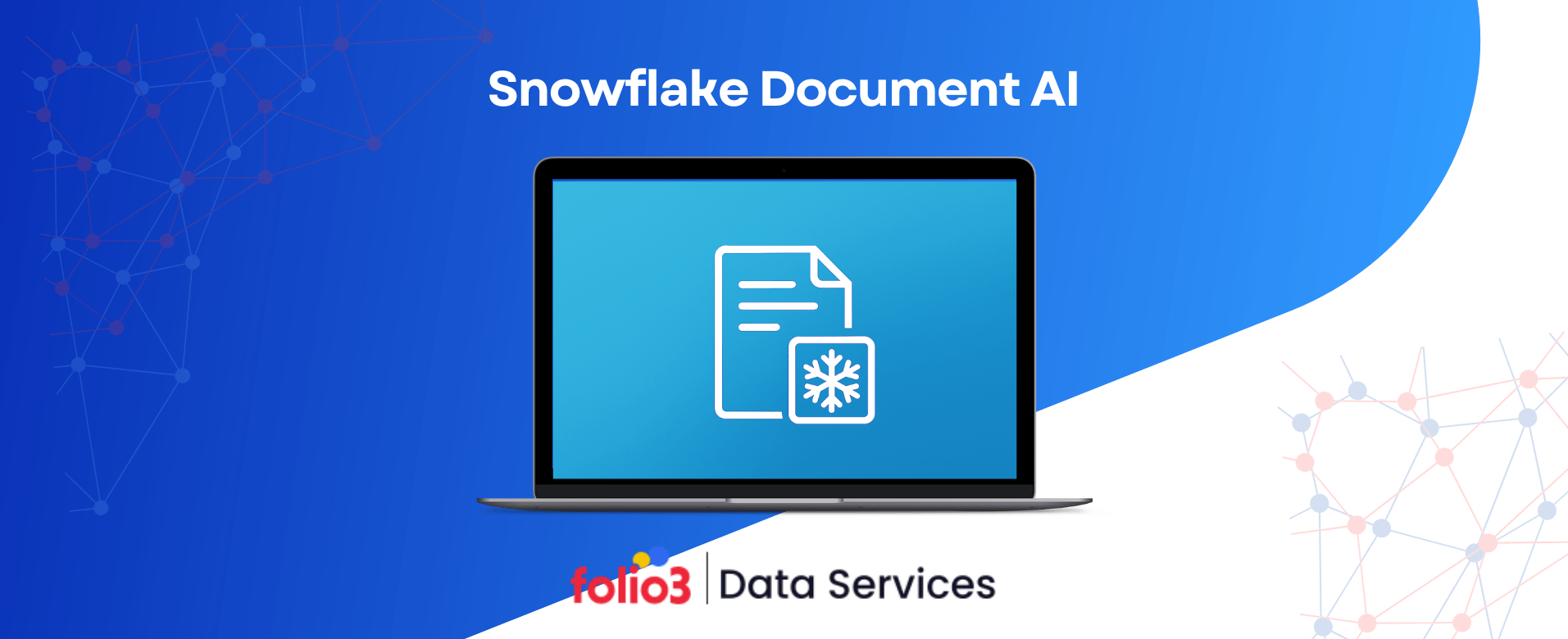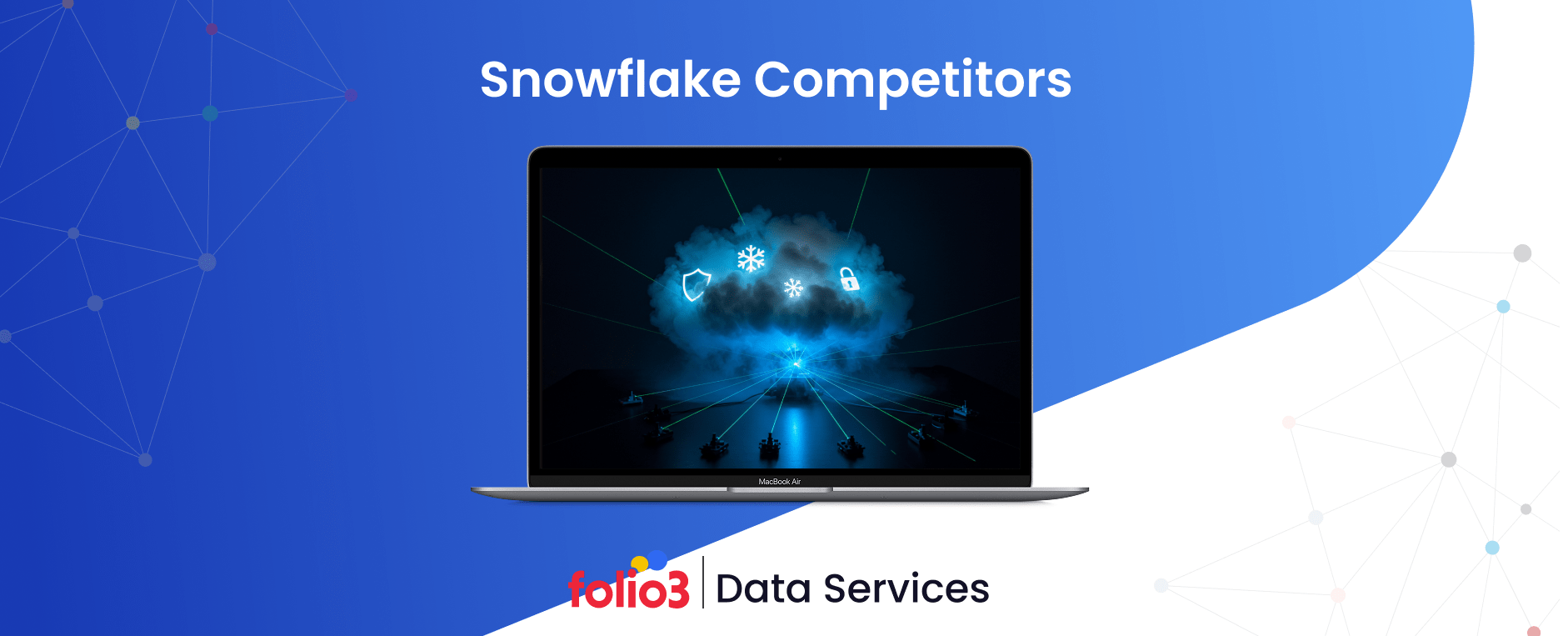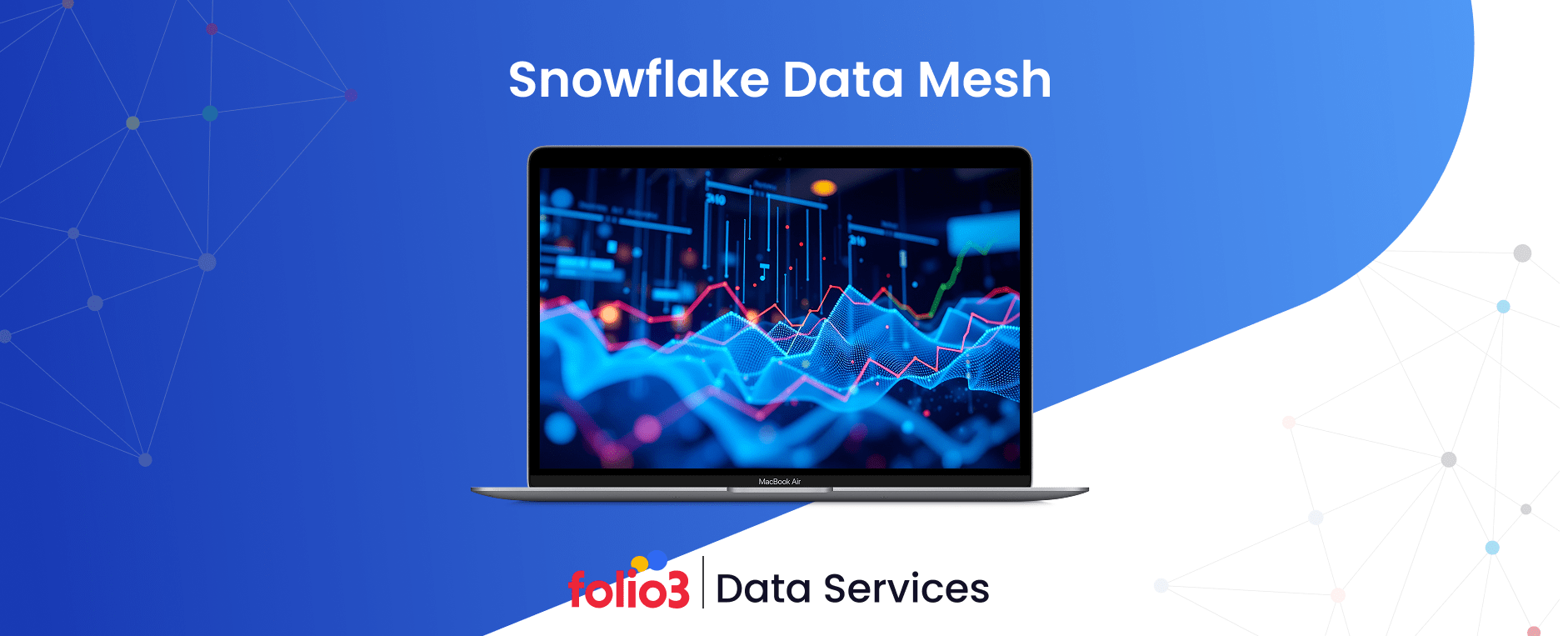80% of enterprise data is unstructured. From invoices and contracts to scanned reports and handwritten forms, organizations are swimming in documents they can’t fully understand or use at scale. As data privacy regulations become stricter and decision-making becomes increasingly data-driven, the ability to process and extract insights from unstructured documents is no longer optional.
That’s where Snowflake Document AI comes in. Purpose-built for businesses already using the Data Cloud, it offers an end-to-end approach to understanding and extracting structured data from complex documents, without moving your data out of Snowflake.
Whether you’re dealing with PDFs, images, or forms, Document AI Snowflake keeps everything inside your existing ecosystem, enhancing data security and simplifying workflows. Snowflake’s native document intelligence offers a timely answer.
This blog will explain what Snowflake Document AI is and how it operates internally. If you’re evaluating document intelligence tools for your organization, this guide will help you understand why staying within your Data Cloud may be your smartest move yet.
The Evolution of Document Intelligence
The way businesses handle documents has undergone a significant transformation. In the past, most document processing involved either manual data entry or basic scanning tools. However, as the volume of unstructured data grows — think invoices, contracts, forms, and handwritten notes — those traditional methods can’t keep up.
To use this information, organizations require more than just text recognition; they need systems that can comprehend and structure data at scale. According to Gartner, 85% of machine learning projects fail to deliver due to the use of unstructured or poor-quality data.
Leveraging resources like Snowflake intelligence documentation can help teams implement more advanced strategies for tackling document understanding effectively.
This section outlines how document processing has evolved from manual labor to OCR and now to more innovative, AI-based systems:
The Shift from Manual Entry to Intelligent Data Extraction
Document processing used to be a painfully manual process, where employees would key in data line by line, which often led to costly mistakes. OCR helps by allowing machines to recognize printed or typed text, reducing human workload. However, OCR systems were limited to basic text extraction and often struggled with layout changes, complex tables, or handwritten notes.
Snowflake’s AI model takes this further by enabling AI data extraction that doesn’t just “read” text but interprets meaning and structure. It can identify which numbers represent totals, which fields contain dates, and which sentences provide context — all within mixed-format documents. This shift is especially valuable now that 80% of enterprise data is unstructured.
Limitations of Traditional OCR and External Processing Tools
Basic OCR engines still cannot understand context. They read everything as flat text and can’t adapt well to new layouts or unexpected inputs. Third-party document tools often require you to send sensitive data outside your secure environment, which increases risk and adds complexity to your tech stack. Integration issues, delayed processing, and limited scalability make them a poor fit for growing data operations.
For example, a typical third-party system might extract a dollar amount but fail to distinguish between a total charge, a tax field, or a discount. These gaps make it hard to feed clean, structured data into analytics tools or compliance systems. Leveraging Snowflake data integration, organizations can streamline and secure the flow of structured data directly into their analytics environment, reducing errors and ensuring better compliance alignment.
Advanced Document Understanding with Snowflake Document AI
Snowflake Document AI is designed to address these challenges. Instead of simply extracting words, it uses large language models (LLMs) trained to understand patterns, context, and document structure. It can interpret form fields, nested data, and even inconsistently formatted inputs, and then convert them into analysis-ready tables or structured outputs within your existing Snowflake environment.
Leveraging core Snowflake features—such as native scalability, built-in security, and seamless data sharing—this solution eliminates the need to move files between systems, reducing both processing time and data privacy risks. You can get started quickly with the official Snowflake Document AI quickstart and explore the Snowflake Document AI documentation for deeper implementation guidance.
By using this native solution, your team can access higher-quality, better-structured data without complicated handoffs, helping your business tap into the 80% of content that’s often left out of decision-making.
Core Capabilities of Snowflake Document AI
Snowflake Document AI offers key features that enable businesses to make sense of the vast volumes of unstructured documents they handle daily. These Snowflake document processing capabilities focus on understanding documents directly inside Snowflake, which reduces the need to move data between systems.
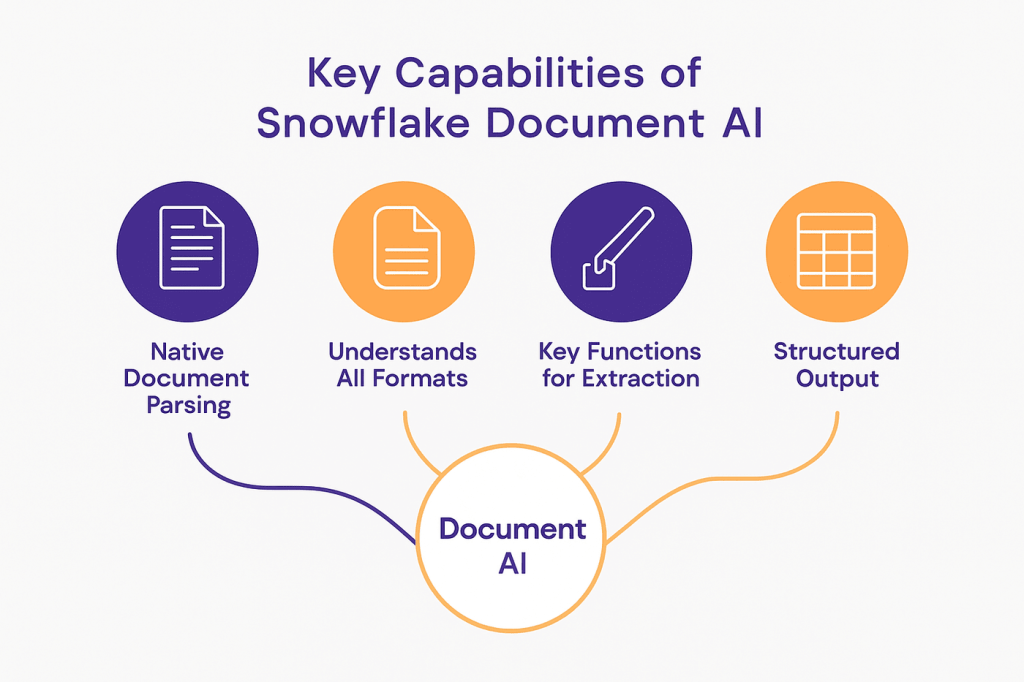
Native document parsing directly in Snowflake
One of the main strengths of Snowflake Document AI is that it can process documents right within the Snowflake Data Cloud. This means that whether you have PDFs, scanned images, or digital forms, Snowflake can read and analyze them without requiring additional tools or external platforms. Thanks to the robust and scalable Snowflake data architecture, everything stays within the platform—saving time and ensuring tighter control over sensitive information.
Understanding tables, forms, text blocks, and more
Documents often contain more than just plain text. There are tables with numbers, forms with fields to fill, and sections of text arranged in different blocks or columns. Snowflake Document AI recognizes these various parts and treats them according to their role. For example, it can identify a table of invoice line items separately from paragraphs of terms and conditions, which helps produce more valuable and organized data.
Key function: EXTRACT_SEMANTIC_CONTENT()
At the heart of Snowflake Document AI’s processing is a specialized function called EXTRACT_SEMANTIC_CONTENT(). This function acts like a smart reader that not only pulls text from documents but also understands the context around it. It identifies relationships between fields, such as matching labels to values in a form or summing numbers in a table. It outputs this information in a format that is easy to work with within Snowflake.
Returning structured results in rows and columns
Instead of delivering raw text, Snowflake Document AI converts the extracted data into structured rows and columns — the familiar format of database tables. This makes it straightforward to run queries, perform analysis, or feed the data into other tools for reporting or compliance checks. The ability to obtain well-organized data without additional transformation steps can save teams a significant amount of time when managing document-heavy workflows. These structured outputs can also enhance Snowflake audience management by enabling more accurate segmentation and personalization based on document-derived insights.
How It Works – Step-by-Step?
Understanding how Snowflake Document AI processes your documents can help you see why it fits well for businesses dealing with large amounts of unstructured data. Here’s a simple breakdown of the typical workflow:
Uploading documents (PDF, image formats)
First, you bring your documents into Snowflake. These can be PDFs, scanned images, or other supported formats, such as TIFF or JPEG. Snowflake allows you to store these files directly within its environment, so everything stays in one place from the start.
Calling Document AI SQL functions
Once your documents are uploaded, you use built-in SQL functions to process them. The primary function, like EXTRACT_SEMANTIC_CONTENT(), reads through the document to identify key pieces of information — such as text, tables, and form fields. This step doesn’t require moving your data outside Snowflake, which helps keep your data protected.
Extracted entities, values, and layout info
The AI extracts specific entities, such as dates, invoice numbers, names, and amounts, along with their corresponding values. It also understands how these pieces are arranged on the page, recognizing tables, sections, and form layouts. This context helps to maintain the meaning and relationships within the document.
By processing this data directly within the Snowflake ecosystem, teams can streamline workflows and reduce dependency on external tools—contributing to Snowflake cost optimization through more efficient resource utilization and simplified infrastructure.
Storing structured results into Snowflake tables
After extraction, the results are converted into a structured format. The data is saved into Snowflake tables with clear rows and columns, making it easy to query. This organized data can then be combined with your existing datasets.
Querying and joining with other datasets
Because the extracted data is stored in a familiar table format, you can run SQL queries on it just like any other data in Snowflake. You can combine this new information with customer records, sales data, or other relevant sources to gain deeper insights and support business processes, such as compliance checks and reporting.
Let’s Maximize Your Snowflake ROI—Fast, Secure, Scalable Data Solutions.
Step-by-Step Guide – How to Process Invoices Using Document AI?
To better understand how Snowflake Document AI works in real life, let’s explore a practical example focused on processing invoices. Invoices are among the most common business documents, and extracting accurate data from them is critical for finance teams, auditors, and anyone managing payments.
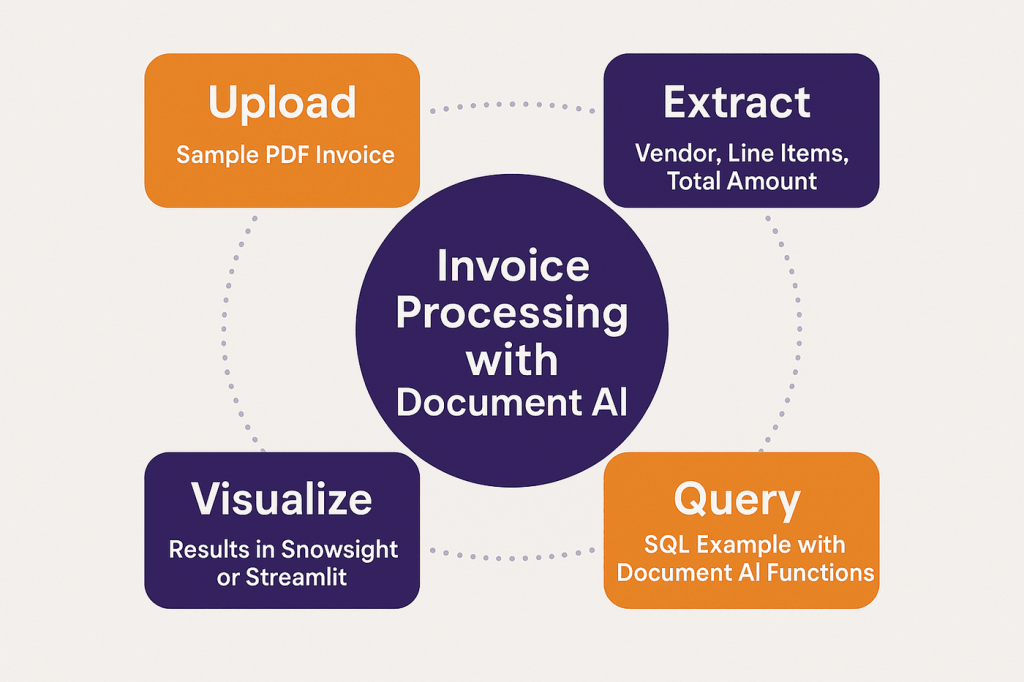
Sample document – PDF invoice
Imagine receiving hundreds or thousands of invoices every month from various vendors. These invoices are typically in PDF format, sometimes accompanied by tables that list items, quantities, prices, and totals. Each invoice can look quite different, with varying layouts, changing fonts, and some even including handwritten notes or stamps.
Traditionally, this meant a lot of manual data entry or using basic Optical Character Recognition (OCR) tools that only extract text but don’t understand the document’s structure or meaning. This often led to errors, missing data, and a lengthy process to make sense of the information. With Snowflake consulting experts, organizations can streamline workflows by integrating advanced data extraction and structuring into Snowflake, enabling cleaner pipelines and faster financial insights.
Extract Vendor, Line Items, and Total Amount
With Snowflake Document AI, you can extract critical elements from these invoices automatically, directly inside your Snowflake environment. The AI understands not just the words but the context and layout, helping to pull out:
- The vendor’s name and contact information.
- Each purchased item has details such as description, quantity, and price.
- The total amount due for the invoice.
Because the tool understands tables and forms, it can correctly identify line items and totals even if the invoice format changes from one vendor to another. This reduces the risk of confusing tax fields with discounts or misreading totals.
SQL Example Using Document AI Functions
One of the strengths of Snowflake Document AI is that it integrates smoothly with your existing SQL workflows. Here’s an example of how you might use it:
SELECT
value:vendor_name::string AS vendor,
line_items.value:item_description::string AS description,
line_items.value:quantity::number AS quantity,
line_items.value:price::number AS price,
value:total_amount::number AS total
FROM
TABLE(
EXTRACT_SEMANTIC_CONTENT(
'pdf_invoice_column'
)
),
LATERAL FLATTEN(input => value:line_items) AS line_items;
This SQL snippet calls the EXTRACT_SEMANTIC_CONTENT() function, which processes the PDF invoice stored in Snowflake. The function extracts structured data, such as vendor names and nested line items, and flattens the data so that each item appears in its row. This makes querying and analysis much easier.
Visualize the results in Snowsight or Streamlit
Once the invoice data is extracted and stored in tables, you can use Snowsight, Snowflake’s web interface, to explore the data directly with SQL queries. Snowsight offers basic visualization tools, enabling you to create charts and summaries for quick insights.
For more advanced or customized views, you might use external tools like Streamlit, a popular open-source app framework for building data dashboards in Python. Streamlit can connect to Snowflake, allowing you to create interactive applications that display invoices, totals, or vendor comparisons in a user-friendly manner.
With guidance from Snowflake modernization consulting, businesses can streamline this setup to ensure optimal performance, security, and scalability. This approach keeps everything within your Snowflake ecosystem, avoiding the need to move sensitive data to external services and simplifying the process—turning complex documents into neat tables that are easy to query and report on.
Integrating Extracted Document Data into Your Existing Workflow
Once you’ve extracted structured data using Snowflake Document AI, the next step is to fit it smoothly into your existing data processes. This means ensuring that the data flows where it needs to go, so your team can use it without any extra hassle.
Automating with Snowflake Tasks and Streams
Snowflake provides tools called Tasks and Streams that help automate these workflows. Tasks can schedule and run SQL commands automatically, while Streams track changes in your tables in real-time. These capabilities integrate seamlessly with structured data models like Snowflake schema and star schema, enabling continuous data processing — for example, automatically extracting data from new invoices as they arrive and routing it into well-organized schemas for analytics, all without manual intervention.
Building Dashboards with BI Tools (Tableau, Power BI)
After your data is organized, you can connect it to popular business intelligence tools, such as Tableau or Power BI. These tools help visualize the data in clear, interactive dashboards, making it easier for decision-makers to understand key insights such as spending trends, vendor performance, or payment statuses.
Combined with AI enterprise search, teams can instantly locate relevant reports or datasets within their BI environment, streamlining data discovery and accelerating decision-making.
Enriching Results with Snowpark ML Models
Snowflake’s Snowpark lets you build and run machine learning models directly where your data lives. This means you can take your extracted document data and apply machine learning (ML) models to predict outcomes or classify information, for example, flagging unusual invoice amounts or identifying patterns in vendor behavior.
Partnering with experts who offer data engineering services ensures these models are integrated efficiently and optimized for your specific business needs.
Exporting Results to External APIs or Apps
Finally, if you need to share your processed data with external applications or APIs, you can export it from Snowflake. This could involve sending invoice data to your accounting system, updating a CRM, or integrating with other tools your organization uses — all of which help keep your workflows connected and efficient.
Security and Privacy for Your Documents in Snowflake
Handling sensitive documents requires more than just powerful extraction tools — it demands strong security and governance to keep data safe and compliant. Snowflake is designed with these priorities in mind.
How Snowflake Keeps Your Document Data Secure
Snowflake stores and processes your documents within its secure Data Cloud environment. This means your files never have to leave the platform, thereby reducing risks associated with data transfers. Snowflake uses encryption both at rest (when data is stored) and in transit (when data is transferred between systems), ensuring that unauthorized users cannot access your document content.
Controlling Access with Role-Based Permissions and Auditing
BigQuery and Snowflake both offer robust role-based access controls (RBAC), but Snowflake enables you to precisely control who can view or manipulate your data through highly granular permission settings. This setup means that different users or teams get only the permissions they need — for example, finance staff can access invoice data, but not sensitive HR documents.
Additionally, Snowflake maintains detailed audit logs of all data access and changes. These logs enable organizations to track who has viewed or modified documents, which is crucial for security monitoring and investigations.
Meeting Compliance Standards (PII, HIPAA, and More)
Many organizations must comply with stringent data privacy regulations, such as protecting personally identifiable information (PII) or adhering to healthcare regulations like HIPAA. Snowflake’s security framework supports compliance by providing tools and controls to manage sensitive data responsibly.
With the right Snowflake data engineering practices, you can configure your environment to limit access to PII and sensitive document fields, demonstrating compliance through Snowflake’s auditing and data governance features. This capability helps businesses stay aligned with regulations while still unlocking value from their documents.
We Help Teams Deploy and Optimize Snowflake with Confidence.
Business Impact of Snowflake Document AI Across Different Industries
Snowflake Document AI isn’t just a technical tool. It helps businesses across various fields manage their documents more easily and accurately. Here’s how it can make a difference in key industries:
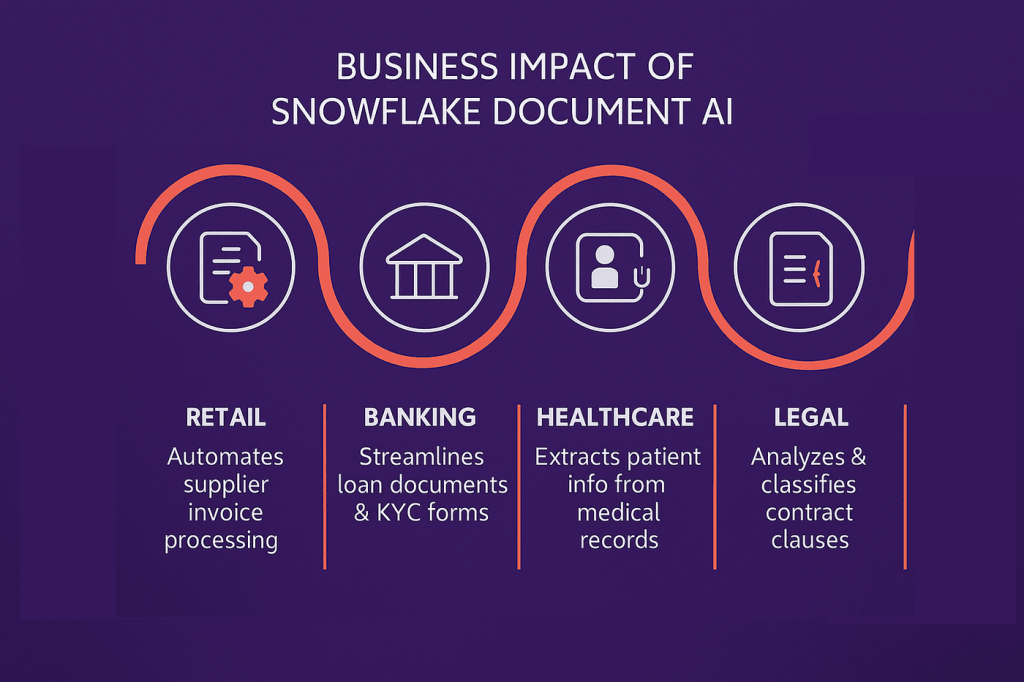
Retail: Automating Supplier Invoice Processing
Retail companies receive many invoices from suppliers. Snowflake Document AI can automatically read these invoices, extracting key details such as vendor names, amounts, and due dates. This reduces manual work and speeds up payment processing.
Banking: Simplifying Loan Documents and KYC Forms
Banks handle a significant amount of paperwork, ranging from loan applications to customer verification, also known as Know Your Customer (KYC). Document AI helps extract the needed information quickly and accurately, making it easier to approve loans or verify identities without delays.
Healthcare: Extracting Patient Information from Medical Records
Healthcare providers manage a wide range of documents, including patient records. Snowflake Document AI can extract key patient details, such as names, dates, and treatments, enabling staff to access important information faster while maintaining patient privacy.
Legal – Analyzing and Classifying Contract Clauses
Law firms and legal departments often require careful review of contracts. Document AI can identify specific clauses or terms in contracts, organize them, and even flag essential points, making legal reviews more efficient and effective.
Limitations of Snowflake Document AI
While Snowflake Document AI is a powerful tool for turning complex documents into structured data, it does have some limits you should keep in mind:
- Accuracy Depends on Document Complexity: The system works best with clean, well-organized documents. When documents have unusual layouts, mixed content types, handwritten notes, or low-quality scans, the AI may miss details or misinterpret information. For example, handwritten invoices or forms with smudges might not be fully recognized.
- Challenges with Poor Image Quality: If a document is blurry, has shadows, or is poorly scanned, the AI might not extract data accurately. This can result in missing or incorrect information, potentially affecting downstream Snowflake data ingestion processes.
- Limited Context Understanding for Some Fields: Although Snowflake Document AI uses advanced models, there may be occasional confusion in distinguishing between similar data fields, such as differentiating a total amount from a tax amount on an invoice.
Important Considerations for Using Snowflake Document AI
To get the best results and avoid common problems, here are some essential things to consider when using Snowflake Document AI:
- Improve Document Quality: The more transparent and consistent your documents are, the better the AI performs. Use high-resolution scans or digital PDFs whenever possible, and avoid handwritten notes. Keep fonts and layouts consistent throughout. Clean, standardized forms enable AI to understand and extract data more accurately.
- Regular Review of Extracted Data: Although the AI reduces manual work, it’s a good idea to spot-check outputs regularly, especially for critical documents. This ensures that errors are caught early, before they impact your reports or decisions.
- Monitor Processing Costs and Time: Snowflake charges based on processing credits, so keep an eye on how many documents you process and their complexity. Processing large batches or detailed files can increase cost and time. Monitoring helps manage budgets and avoid unexpected slowdowns.
- Plan for Document Variety: If your organization handles a wide range of document types, such as invoices, contracts, and handwritten forms, consider testing how well Document AI performs to each kind. Some documents may require extra preparation or manual intervention.
FAQs
How does Snowflake Document AI differ from traditional OCR tools?
Snowflake Document AI surpasses traditional OCR by understanding the context and structure within documents, delivering more accurate and meaningful data extraction within your Snowflake environment. Unlike basic OCR, it interprets complex layouts and nested fields.
How can I integrate Document AI into my data pipeline?
You can integrate Document AI Snowflake functions directly within your existing Snowflake workflows, using SQL calls to extract data and then automate processing with Snowflake Tasks and Streams for seamless data flow.
How secure is document processing in Snowflake?
Document processing with Snowflake Document AI benefits from Snowflake’s built-in security features, including role-based access controls, data encryption, and auditing, ensuring your sensitive data stays protected within the Data Cloud.
What industries can benefit from Snowflake Document AI?
Industries like retail, banking, healthcare, and legal can all benefit from Snowflake Document AI by automating document intake and extracting critical data for faster, more reliable business operations.
Conclusion
Snowflake Document AI provides a powerful way for organizations to unlock the value hidden in unstructured documents, all within the Snowflake Data Cloud. By combining advanced AI capabilities with native integration, it simplifies the extraction of meaningful data from invoices, contracts, forms, and more, all while keeping data secure.
As businesses face increasing volumes of complex documents, adopting a tool like Document AI Snowflake can enhance accuracy, reduce manual labor, and expedite decision-making. To fully unlock the potential of your document data and broader data initiatives, partnering with experts like Folio3 can make all the difference.Folio3 data services offer end-to-end solutions, including Snowflake implementation, data engineering, integration, and advanced analytics, helping you design, optimize, and scale your data workflows for lasting business impact. Together, Snowflake Document AI and Folio3’s expertise pave the way for smarter and successful growth.
